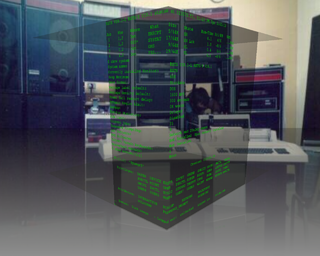Variable Assembly Language (VAL) is a computer-based control system and language designed specifically for use with Unimation Inc. industrial robots.
A computer is a device that can be instructed to carry out sequences of arithmetic or logical operations automatically via computer programming. Modern computers have the ability to follow generalized sets of operations, called programs. These programs enable computers to perform an extremely wide range of tasks. A "complete" computer including the hardware, the operating system, and peripheral equipment required and used for "full" operation can be referred to as a computer system. This term may as well be used for a group of computers that are connected and work together, in particular a computer network or computer cluster.

A control system manages, commands, directs, or regulates the behavior of other devices or systems using control loops. It can range from a single home heating controller using a thermostat controlling a domestic boiler to large Industrial control systems which are used for controlling processes or machines.
Unimation was the world's first robotics company. It was founded in 1962 by Joseph F. Engelberger and George Devol and was located in Danbury, Connecticut. Devol had already applied for a patent an industrial robotic arm in 1954; U.S. Patent 2,988,237 was issued in 1961.
Contents
- Terminology
- Monitor
- Editor
- Location
- VAL programming
- The VAL system
- External communication
- VAL Operating System
- References
The VAL robot language is permanently stored as a part of the VAL system. This includes the programming language used to direct the system for individual applications. The VAL language has an easy to understand syntax. It uses a clear, concise, and generally self-explanatory instruction set. All commands and communications with the robot consist of easy to understand word and number sequences. Control programs are written on the same computer that controls the robot. As a real-time system, VAL's continuous trajectory computation permits complex motions to be executed quickly, with efficient use of system memory and reduction in overall system complexity. The VAL system continuously generates robot control commands, and can simultaneously interact with a human operator, permitting on-line program generation and modification.

A robot is a machine—especially one programmable by a computer— capable of carrying out a complex series of actions automatically. Robots can be guided by an external control device or the control may be embedded within. Robots may be constructed on the lines of human form, but most robots are machines designed to perform a task with no regard to how they look.
In computer science, real-time computing (RTC), or reactive computing describes hardware and software systems subject to a "real-time constraint", for example from event to system response. Real-time programs must guarantee response within specified time constraints, often referred to as "deadlines". The correctness of these types of systems depends on their temporal aspects as well as their functional aspects. Real-time responses are often understood to be in the order of milliseconds, and sometimes microseconds. A system not specified as operating in real time cannot usually guarantee a response within any timeframe, although typical or expected response times may be given.

A trajectory or flight path is the path that a object with mass in motion follows through space as a function of time. In classical mechanics, a trajectory is defined by Hamiltonian mechanics via canonical coordinates; hence, a complete trajectory is defined by position and momentum, simultaneously. Trajectory in quantum mechanics is not defined due to Heisenberg uncertainty principle that position and momentum can not be measured simultaneously.
A convenient feature or VAL is the ability to use libraries or manipulation routines. Thus, complex operations may be easily and quickly programmed by combining predefined subtasks.
The VAL language consists of monitor commands and program instructions. The monitor commands are used to prepare the system for execution of user-written programs. Program instructions provide the repertoire necessary to create VAL programs for controlling robot actions.





